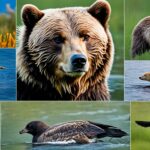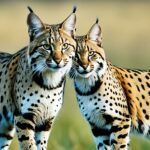The USA has a lot of wildlife, but wild leopards aren’t part of it. The southern states used to be home to big cats like the ocelot, which looks a bit like a small leopard. Now, these big cats are found in only a few areas such as Arizona and southern Texas.
To figure out if wild leopards live in the USA, we need to look at big cat stats, where they used to live, and any seen today. Despite stories about North America leopards, there have never been leopards living wild in the USA.
Introduction to Big Cats in North America
North America is home to amazing wild cats. Each one has found its place in the diverse landscapes. While leopards can’t be found in the USA, there are other big cats here.
Overview of Big Cats
Ocelots, jaguarundis, and jaguars are among North America’s big cats. They live in various places, from Arizona’s deserts to South America’s tropics. These cats have adapted in amazing ways to survive.
Differences Between Jaguars and Leopards
It’s important to know how jaguars and leopards differ. Jaguars are stronger-built than leopards and have a different jaw shape. They’re also different in where they live. Jaguars were once in the southwestern USA, but now live mainly in South America. Leopards, however, can be found in Africa, Asia, and small parts of the Middle East. They have never been native to North America.
leopard conservation efforts globally.
Carlos Arroyo, a conservation biologist, says, “It’s key to know these differences for the right protection steps.”
The US doesn’t have leopards, but we should focus on our own big cats. Saving big cats habitats North America not only protects them but also celebrates North America’s wild spirit.
| Big Cat Species | Native Region | Habitat |
|---|---|---|
| Ocelot | Southern USA to South America | Rainforests, mangrove forests |
| Jaguarundi | Texas to South America | Brushlands, tropical forests |
| Jaguar | Southwestern USA to South America | Tropical forests, swamps |
| Leopard | Africa, Asia, Middle East | Rainforests to savannas |
Historical Range of Leopards and Other Big Cats
Leopards have been found mainly in Africa, Asia, and some of the Middle East over history. However, there were no native leopards in North America. Despite this, talks about big cats in North America usually include jaguars. This is because jaguars used to live extensively across the continent.
Leopard Sightings in History
Sightings of leopards in the USA are usually not real. People often mistake other big cats like jaguars, ocelots, and jaguarundis for leopards. Jaguars in particular look a lot like leopards. This has created a myth that leopards were present in North America.
Comparison to Jaguar Range
Looking at the jaguar historical range sheds light on how big cats were distributed in the USA. Jaguars lived from Southern California to North Carolina and further in Central and South America. They found suitable homes in these areas for survival. By the early 1900s, their numbers in the U.S. dropped, with the last wild jaguar seen then. Now, there are efforts to bring jaguars back in places like Arizona and New Mexico. This aims to increase their population and help the environment.
| Feature | Leopard | Jaguar |
|---|---|---|
| Native Regions | Africa, Asia, Middle East | Americas (Southern California to Central and South America) |
| Historical Range in USA | None | Southern California to North Carolina |
| Common Mistaken Sightings | Jaguars, ocelots, jaguarundis | Leopards, particularly due to their similar coat patterns |
| Conservation Efforts | Focused globally, non-native to USA | Active in the USA, particularly Arizona and New Mexico |
Current Leopard Habitat in the USA
Let’s clear up some things. Leopards don’t live naturally in the USA. The big cats that look like leopards but live near Mexico are jaguars and jaguarundis. So, there’s no current leopard habitat in the USA.
Jaguars mostly live in places like Arizona and New Mexico. These are protected areas. Jaguarundis live in small areas near the border too. People are working hard to make sure the spaces where they live are safe and different from where leopards might live.
Save the wild cats! Leopards should be in Africa and Asia, not the USA. Projects across America are protecting native big cats. They’re telling everyone that leopards don’t belong here.
| Big Cat Species | Current Habitat | Remark |
|---|---|---|
| Jaguar | Arizona, New Mexico | Confined to conservation zones |
| Jaguarundi | Texas border regions | Often mistaken for leopards |
| Leopard | None | Not indigenous to USA |
Jaguar Sightings and Mistaken Identity
Big cat sightings in the United States recently focused on El Jefe. He’s a unique jaguar seen in Arizona’s Santa Rita Mountains.
El Jefe’s sightings show us the mysterious life of these giant cats. But, it also highlights how people often mistake jaguars for leopards when they see them.
The Story of El Jefe
Wildlife lovers are fascinated by El Jefe’s story. His life alone in the USA proves jaguars are not myths. Yet, many at first think he’s a leopard due to his looks. This confusion also affects understanding big cat sightings.
Other Big Cats Mistaken for Leopards
Apart from jaguars, people can confuse bobcats and jaguarundis with leopards. It’s because they all share similar spotted coats. These mistakes affect efforts to protect big cats correctly in the USA.
The table below helps to see the differences among jaguars, jaguarundis, and bobcats.
| Species | Coat Pattern | Size | Habitat |
|---|---|---|---|
| Jaguar (El Jefe) | Rosette patterns with a central spot | Larger; up to 250 lbs | Forests, mountains |
| Jaguarundi | Solid, unspotted | Medium; up to 20 lbs | Brushlands, forests |
| Bobcat | Spotted or mottled | Small to medium; up to 40 lbs | Forests, swamps, deserts |
Learning the key differences reduces leopard mistaken identity. This, in turn, helps protect big cats around us.
Characteristics of Leopards
Leopards are known for how well they adapt. They have many different skills and live in many places. This includes forests and deserts.
Physical Attributes
Leopards have a special spotted coat. It helps them hide in many environments. They have strong bodies and sharp teeth, which helps them hunt. Even though they’re not the biggest cats, they’re very strong.
- Weight: 66-176 pounds
- Length: 4.25-6.25 feet, excluding the tail
- Lifespan: 12-17 years in the wild
Behavior and Habitat Preferences
Leopards like to be alone and mark their territory. They hunt at night and take their food up trees. This keeps it safe from other animals.
They can live in grasslands, forests, or even high mountains. Leopards are good at swimming and climbing. They pick homes that have a lot of animals to eat and places to hide.
| Characteristic | Description |
|---|---|
| Activity | Nocturnal |
| Hunting Style | Stalk and ambush |
| Diet | Carnivorous, feeding on a variety of prey |
| Habitat Preferences | Grasslands, forests, mountainous regions |
Are there wild leopards in the USA?
Looking into the question, are there wild leopards in the USA, is important. We know that, right now, experts agree that there are no wild leopards in the United States. Some people have claimed to see leopards, but these sightings are usually of other big cats or local animals.
People often see jaguars or bobcats, thinking they are leopards. This shows why it’s so crucial to double-check before saying a wild leopard has been seen. Leopards live in Africa, Asia, and some parts of the Middle East. They are not native to North America.
To deal with the idea of leopard sightings in the USA, we need to know the differences between leopards and other big cats that live here. Knowing these differences makes it clear that leopards have never lived in the wild in the USA.
In the end, although the issue of are there wild leopards in the USA remains, we can say from what we know now that any claimed sightings likely involve other, more common species in the area.
Conservation Efforts for Big Cats
In the USA, conservation efforts focus on big cats like jaguars and ocelots. Many organizations are working hard. They help increase the numbers of these animals. They also protect their habitats.
Programs in Place
The Wildlife Conservation Society is dedicated to this cause. They work with groups all over the world. Their main goal is to keep jaguars and ocelots safe. They do this by helping to restore and protect their homes.
In addition to this, other groups work closely with local communities. They teach people how to aid in saving these beautiful creatures. Community education and involvement are key strategies.
Challenges in Conservation
Conservation faces big challenges in the USA. Things like growing cities and new roads threaten big cat habitats. Actions of people also harm these animals. Efforts to protect them are ongoing.
Despite these challenges, there is hope. Groups working together can make a difference. They aim to keep these big cat species alive and well.
Here is a brief overview of the challenges and initiatives in a structured format:
| Conservation Program | Focus Area | Main Challenge |
|---|---|---|
| Wildlife Conservation Society | Habitat Restoration | Urban Development |
| Community-Based Projects | Education and Empowerment | Human Encroachment |
Leopard Sightings Reported in North America
Leopards usually live far from North America. Yet, there have been reports of leopard sightings in the USA. These reports are quite interesting but also lead to conversations about if they are real.
States with Reported Sightings
Leopard sightings have been reported in California, Texas, and Florida. People have seen them and even taken photos. Despite this, there is no solid proof to back up these claims. Because there are many different places in the USA, it’s not rare for people to think they’ve seen a leopard.
Analysis of Sightings
When we look into these sightings, we often find it’s a case of mistaken identity. Cougars, bobcats, and other big cats are sometimes confused with leopards. Looking closely, there often isn’t enough proof. This shows it’s more likely the local wild cats people are seeing.
Common Animals Mistaken for Leopards in the USA
In the USA, some natural animals look like leopards. This can happen because they look alike. They share patterns in their coats and like to stay hidden.

Ocelots
In places like southern Texas and Arizona, ocelots are often thought to be leopards. These small, spotted cats can easily be mistaken from a distance. They are mostly active at night, which adds to the confusion.
Jaguarundis
Jaguarundis, found in the southern USA, might look like leopards at first glance. Their body shape and color might confuse people, even though they are different from ocelots. Being small and secretive makes them easy to misidentify.
Black Bobcats
Black bobcats are also sometimes thought to be leopards. While they’re not often seen, their dark fur stands out clearly. This makes them a big part of the false leopard sighting reports.
| Species | Distinctive Features | Regions Found |
|---|---|---|
| Ocelots | Spotted coat, nocturnal | Southern Texas, Arizona |
| Jaguarundis | Uniform coat color, elongated body | Southern USA |
| Black Bobcats | Melanistic, dark coat | Various regions |
The Role of Public Perception in Leopard Sightings
Leopards are often shown in a certain way in the media. This can make people think they exist in the U.S. more than they really do. The mix of facts and excitement in the media can lead to many people misunderstanding the truth about leopards here.
Media Influence
The media is powerful in how it shapes our views, even unknowingly. Types of media like films and news often show leopards, making people believe they’re actually around. This can lead to many mistaken reports of leopard sightings in the U.S. However, leopards don’t live in the wild here.
Misconceptions and Myths
Many myths exist about leopards, adding to the confusion. People might see animals like jaguarundis and think they’re leopards. This happens because not everyone knows the local wildlife well enough. So, stories of leopard sightings in non-native areas are common but inaccurate.
Correcting these misconceptions is crucial to understanding the U.S. wildlife better. By clearly showing what is real and what is not, we can keep the facts straight about leopards here. This way, we improve our knowledge about big cats in the U.S.
Future Outlook for Big Cats in the USA
The future for big cats in the USA relies heavily on strong conservation actions and saving their habitat. Leopards won’t breed naturally in the United States because they’re not from here. But, there’s hope for other big cats like jaguars, ocelots, and jaguarundis. Programs are working to bring these cats back to where they used to live.
To help big cats, people are working to keep their natural homes safe and even make them bigger. Local wildlife groups and international organizations, such as the Wildlife Conservation Society, are working hard. They are making sure there are enough places for these cats to live and grow. Making sure they can move from one safe area to another without problems is very important.
By keeping up these efforts, we hope to not just keep big cat numbers steady. We also want to make sure they’re doing well in their homes. Teaching others about these cats and getting everyone involved is key. This way, we can protect the balance of nature in North America by focusing on the big cats that naturally belong here.
FAQ
Are there wild leopards in the USA?
No, wild leopards are not native to the USA. They mainly live in Africa, Asia, and the Middle East.
What big cats are native to North America?
North America has ocelots, jaguarundis, and jaguars. Jaguars used to live in the U.S. but now they’re south of it. Ocelots and jaguarundis are in places like Texas and Arizona.
How do jaguars differ from leopards?
Jaguars are bigger and stronger than leopards. Their coat has a different spotting. They come from different places and act differently too.
Have leopards ever been part of the historical range in North America?
No, leopards never lived in North America in the past. But, jaguars used to be in many states from Southern California to North Carolina.
Is there any current habitat for leopards in the USA?
No, leopards don’t have natural places to live in the USA. They’re from other parts of the world.
Who is El Jefe?
El Jefe is a famous jaguar living in Arizona’s Santa Rita Mountains. His presence shows how rare jaguars are in the U.S.
What animals are often mistaken for leopards in the USA?
Ocelots, jaguarundis, and black bobcats are sometimes wrongly thought to be leopards. They look similar but are different species.
What are the physical attributes of leopards?
Leopards have spotted coats, are strong, and move well. They like to be alone and can live in many places, like forests and plains.
What conservation efforts are in place for big cats in the USA?
Groups like the Wildlife Conservation Society are protecting big cat homes and growing their numbers. They’re fighting against things like cities destroying the land.
Are there reports of leopard sightings in the USA?
Yes, some people say they’ve seen leopards. But these stories often don’t get proven and are likely mistakes with other animals. These can be local cats or cougars that look a bit different.
What role does media play in public perception of leopard sightings?
The media can change what people think and add to wrong beliefs about seeing a leopard. It’s important to share true facts to help tell big cats apart.
What does the future look like for big cats in the USA?
The future for big cats here needs saving their homes and caring for them. Leopards won’t naturally live here. But local big cats can grow if we look after them well.







